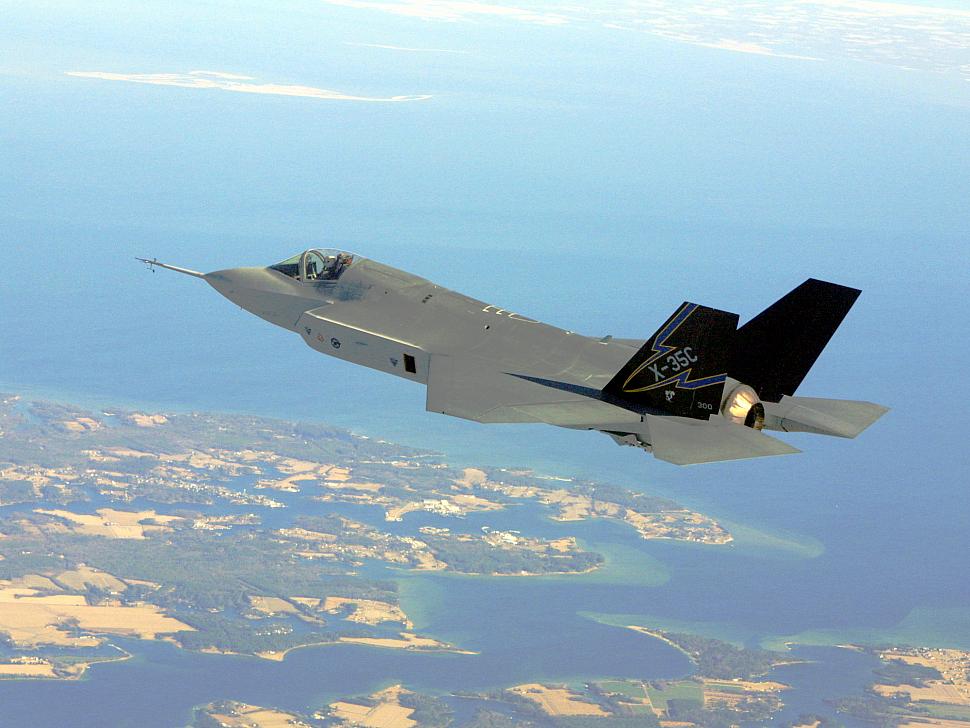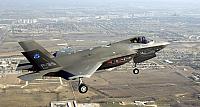Fighter Jet News
F-35 Lightning II News
Carrier version of F-35 cleared for production
June 23, 2007 (by
Lieven Dewitte) -
All three versions of the U.S. Joint Strike Fighter have now cleared the final milestone needed before entering the production phase.

The U.S. Navy's F-35C Lightning II carrier version of the F-35 recently passed its Air System Critical Design Review (CDR), putting it on track for Low Rate Initial Production. The CDR is a significant development milestone that verifies the design maturity of the aircraft and its associated systems
The conventional takeoff and landing (F-35A - CTOL) and short-takeoff and vertical landing (F-35B - STOVL) variants of the plane passed the CDR earlier and have been approved for LRIP. While the Carier variant (F-35C - CV) shares its fundamental design with those two versions, it is specialized for the catapult launches and arrested recoveries of large aircraft carriers. It features 30 percent more wing area than the other two variants, larger tails and control surfaces, and wingtip ailerons -- all contributing to the precise slow-speed handling characteristics required for carrier approaches. The F-35C's internal structure is strengthened to withstand the punishment of repeated catapult launches and arrested recoveries on the carrier deck.
The review was conducted June 18-22 at Lockheed Martin in Fort Worth, and involved officials from Naval Air Systems Command (NAVAIR), the Joint Strike Fighter Program Office, the F-35 international-participant nations and the F-35 contractor team. Completion of the CDR is a prerequisite for the F-35C to move into Low Rate Initial Production.
"Completion of this design review is a very significant milestone -- the die is now fully cast for the unique, three-variant Joint Strike Fighter program envisioned when the planning began in the late 1990s," said JSF Program Executive Officer Brig. Gen. C.R. Davis. "This is a momentous day never seen in another acquisition program in history. The entire team should be proud of the work that got us here today."
Lockheed Martin said in a statement Thursday that the naval variant, designated the F-35C, had an extra 200 pounds shaved off its design prior to the CDR.
The F-35C will be the Navy's first stealthy plane and will eventually replace the F/A-18 Hornet and fly alongside the newer F/A-18E/F Super Hornet as the main combat assets of U.S. naval aviation. The F-35A is the conventional version for the Air Force and will supplant the F-16 and A-10 attack planes beginning in 2010 while the F-35B will replace the Harrier jets flown by the U.S. Marines and the British military.
Funding for the first two production-model Lightning IIs -- both conventional takeoff and landing versions -- is approved and fabrication for those aircraft has begun. The pair of F-35A aircraft are the first of 1,763 scheduled for delivery to the U.S. Air Force, beginning in 2010. The U.S. Marine Corps and Navy together are planning to operate 680 F-35Bs and F-35Cs, and the United Kingdom plans to place 138 F-35Bs into service with the Royal Air Force and Royal Navy. The remaining F-35 participant countries plan to acquire more than 700 aircraft.

The X-35C which underwent flight testing in 2000 and 2001 and conducted much of its carrier-suitability testing at the Patuxent River Naval Air Station, is now exhibited at Patuxent River Naval Air Museum in Maryland.
The conventional takeoff and landing (F-35A - CTOL) and short-takeoff and vertical landing (F-35B - STOVL) variants of the plane passed the CDR earlier and have been approved for LRIP. While the Carier variant (F-35C - CV) shares its fundamental design with those two versions, it is specialized for the catapult launches and arrested recoveries of large aircraft carriers. It features 30 percent more wing area than the other two variants, larger tails and control surfaces, and wingtip ailerons -- all contributing to the precise slow-speed handling characteristics required for carrier approaches. The F-35C's internal structure is strengthened to withstand the punishment of repeated catapult launches and arrested recoveries on the carrier deck.
The review was conducted June 18-22 at Lockheed Martin in Fort Worth, and involved officials from Naval Air Systems Command (NAVAIR), the Joint Strike Fighter Program Office, the F-35 international-participant nations and the F-35 contractor team. Completion of the CDR is a prerequisite for the F-35C to move into Low Rate Initial Production.
"Completion of this design review is a very significant milestone -- the die is now fully cast for the unique, three-variant Joint Strike Fighter program envisioned when the planning began in the late 1990s," said JSF Program Executive Officer Brig. Gen. C.R. Davis. "This is a momentous day never seen in another acquisition program in history. The entire team should be proud of the work that got us here today."
Lockheed Martin said in a statement Thursday that the naval variant, designated the F-35C, had an extra 200 pounds shaved off its design prior to the CDR.
The F-35C will be the Navy's first stealthy plane and will eventually replace the F/A-18 Hornet and fly alongside the newer F/A-18E/F Super Hornet as the main combat assets of U.S. naval aviation. The F-35A is the conventional version for the Air Force and will supplant the F-16 and A-10 attack planes beginning in 2010 while the F-35B will replace the Harrier jets flown by the U.S. Marines and the British military.
Funding for the first two production-model Lightning IIs -- both conventional takeoff and landing versions -- is approved and fabrication for those aircraft has begun. The pair of F-35A aircraft are the first of 1,763 scheduled for delivery to the U.S. Air Force, beginning in 2010. The U.S. Marine Corps and Navy together are planning to operate 680 F-35Bs and F-35Cs, and the United Kingdom plans to place 138 F-35Bs into service with the Royal Air Force and Royal Navy. The remaining F-35 participant countries plan to acquire more than 700 aircraft.
Related articles:
Forum discussion:
Tags
- U.S. Navy and U.K. Royal Navy F-35 unable to get aboard ship ( 2012-01-08)
- USMC and Navy JSF assembly reaches milestones ( 2006-12-20)
- Nas Pax River facility to test F-35 jets for the Navy and Marine Corps ( 2006-01-30)
- F-35 Lightning II news archive
Forum discussion:
- Start a discussion about this article in the F-35 forum.
Tags


